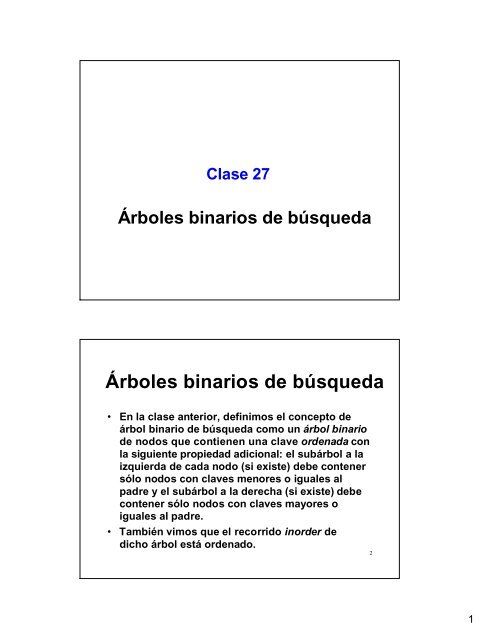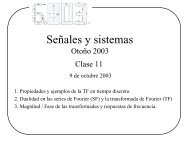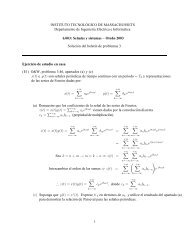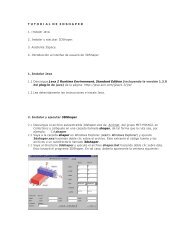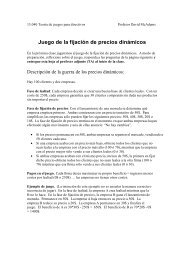Árboles binarios de búsqueda
Árboles binarios de búsqueda
Árboles binarios de búsqueda
You also want an ePaper? Increase the reach of your titles
YUMPU automatically turns print PDFs into web optimized ePapers that Google loves.
Clase 27<br />
<strong>Árboles</strong> <strong>binarios</strong> <strong>de</strong> <strong>búsqueda</strong><br />
<strong>Árboles</strong> <strong>binarios</strong> <strong>de</strong> <strong>búsqueda</strong><br />
• En la clase anterior, <strong>de</strong>finimos el concepto <strong>de</strong><br />
árbol binario <strong>de</strong> <strong>búsqueda</strong> como un árbol binario<br />
<strong>de</strong> nodos que contienen una clave or<strong>de</strong>nada con<br />
la siguiente propiedad adicional: el subárbol a la<br />
izquierda <strong>de</strong> cada nodo (si existe) <strong>de</strong>be contener<br />
sólo nodos con claves menores o iguales al<br />
padre y el subárbol a la <strong>de</strong>recha (si existe) <strong>de</strong>be<br />
contener sólo nodos con claves mayores o<br />
iguales al padre.<br />
• También vimos que el recorrido inor<strong>de</strong>r <strong>de</strong><br />
dicho árbol está or<strong>de</strong>nado.<br />
2<br />
1
Objetivos<br />
• Implementaremos un árbol binario <strong>de</strong><br />
<strong>búsqueda</strong> y analizaremos la<br />
implementación.<br />
• Las generalizaciones <strong>de</strong> los árboles<br />
<strong>binarios</strong> <strong>de</strong> <strong>búsqueda</strong> aportan<br />
aplicaciones importantes, incluidas las<br />
bases <strong>de</strong> datos comerciales.<br />
• La implementación le dará una i<strong>de</strong>a <strong>de</strong> los<br />
métodos <strong>de</strong> árboles que suelen ser más<br />
"visuales" o "topológicos" que las<br />
implementaciones <strong>de</strong> arrays o listas.<br />
3<br />
Claves y valores<br />
• Si los árboles <strong>binarios</strong> <strong>de</strong> <strong>búsqueda</strong><br />
están or<strong>de</strong>nados, <strong>de</strong>ben estarlo según<br />
alguna clave incluida en cada nodo <strong>de</strong>l<br />
árbol.<br />
• Un nodo pue<strong>de</strong> contener únicamente la<br />
clave, pero suele resultar útil permitir que<br />
cada nodo contenga una clave y un valor.<br />
• La clave se utiliza para analizar el nodo.<br />
El valor es un dato adicional <strong>de</strong>l nodo<br />
in<strong>de</strong>xado por la clave.<br />
4<br />
2
Mapas<br />
• Las estructuras <strong>de</strong> datos con pares<br />
clave/valor suelen recibir el nombre <strong>de</strong><br />
mapas.<br />
• Como ejemplo, consi<strong>de</strong>re las entradas <strong>de</strong><br />
una agenda <strong>de</strong> teléfonos tal como se<br />
insertarían en un árbol binario <strong>de</strong><br />
<strong>búsqueda</strong>. El apellido <strong>de</strong>l abonado sería<br />
la clave y el número <strong>de</strong> teléfono sería el<br />
valor.<br />
Tipo <strong>de</strong> claves y valores<br />
• A veces el valor no es necesario, pero si un<br />
nodo tiene un valor, probablemente quiera<br />
que todos lo tengan.<br />
• Tampoco hemos especificado el tipo <strong>de</strong> la clave<br />
y <strong>de</strong>l valor. Pue<strong>de</strong>n ser <strong>de</strong> cualquier clase que<br />
<strong>de</strong>see, pero todos los nodos <strong>de</strong>ben contener<br />
claves y valores que sean instancias <strong>de</strong> la<br />
misma clase.<br />
• Las claves y los valores no tienen por qué ser<br />
<strong>de</strong>l mismo tipo. Se pue<strong>de</strong>n tratar como objetos<br />
en la implementación <strong>de</strong>l árbol, salvo en el<br />
momento en que necesitemos compararlos.<br />
5<br />
6<br />
3
Claves duplicadas<br />
• ¿Permitimos que el árbol contenga nodos<br />
con claves idénticas?<br />
• No hay nada en el concepto <strong>de</strong> los árboles<br />
<strong>binarios</strong> <strong>de</strong> <strong>búsqueda</strong> que impida las claves<br />
duplicadas.<br />
• En la interfaz que implementemos, utilizaremos<br />
las claves para acce<strong>de</strong>r a los valores. Si<br />
permitimos la existencia <strong>de</strong> claves idénticas, no<br />
podríamos distinguir nodos distintos que posean<br />
la misma clave.<br />
• Por tanto, en esta implementación, no se<br />
permiten claves duplicadas. Los valores<br />
duplicados asociados a claves distintas sí están<br />
permitidos.<br />
7<br />
InterfazSortedMap<br />
public interface SortedMap {<br />
// las claves no pue<strong>de</strong>n ser null pero los valores sí<br />
public boolean isEmpty();<br />
}<br />
public void clear();<br />
public int size();<br />
public Object get( Object key );<br />
public Object firstKey();<br />
public Object lastKey();<br />
public Object remove( Object key );<br />
public Object put( Object key, Object value );<br />
public MapIterator iterator();<br />
8<br />
4
Notas <strong>de</strong>SortedMap<br />
get(), firstKey(), lastKey() <strong>de</strong>vuelven los<br />
valores a<strong>de</strong>cuados y <strong>de</strong>jan el par clave/valor en el<br />
mapa.<br />
firstKey() y lastKey() <strong>de</strong>vuelvennull si el<br />
mapa está vacío<br />
remove() <strong>de</strong>vuelve el valor si la clave está presente;<br />
<strong>de</strong> lo contrario, <strong>de</strong>vuelvenull<br />
put(): si la clave no está en el mapa, inserta el<br />
nuevo par clave/valor; si la clave ya está<br />
presente, <strong>de</strong>vuelve el valor antiguo y lo sustituye<br />
por el valor nuevo en el mapa<br />
InterfazMapIterator<br />
public interface MapIterator<br />
{<br />
public boolean hasNext();<br />
public Object next()<br />
throws NoSuchElementException;<br />
public Object remove()<br />
throws IllegalStateException;<br />
public Object key()<br />
throws IllegalStateException;<br />
public Object getValue()<br />
throws IllegalStateException;<br />
public Object setValue( Object value )<br />
throws IllegalStateException;<br />
}<br />
9<br />
10<br />
5
Comparator<br />
Si las claves son objetos arbitrarios, ¿cómo<br />
se or<strong>de</strong>nan?<br />
El usuario pue<strong>de</strong> crear su propio comparador<br />
public interface Comparator<br />
{<br />
}<br />
// Ni o1 ni o2 pue<strong>de</strong>n ser null<br />
public int compare(Object o1, Object o2);<br />
StringComparator<br />
public class StringComparator<br />
implements Comparator<br />
{<br />
}<br />
public int compare(Object o1, Object o2)<br />
{<br />
}<br />
return ((String) o1).compareTo((String) o2);<br />
BinarySearchTree btree =<br />
new BinarySearchTree( new StringComparator() );<br />
11<br />
12<br />
6
Interfaz Comparable<br />
• En versiones recientes <strong>de</strong>l JDK, todas las clases<br />
empaquetadas para tipos incorporados implementan<br />
una interfazComparable in<strong>de</strong>pendiente:<br />
public interface Comparable<br />
{<br />
public int compareTo(Object o);<br />
}<br />
• Como String implementa la interfaz Comparable, no<br />
necesitamos implementar el comparador especial<br />
StringComparator.<br />
• El método compareTo() <strong>de</strong>vuelveints con el mismo<br />
sentido que la interfaz Comparator.<br />
Implementación <strong>de</strong> BinarySearchTree<br />
• Tendremos un árbol y clases <strong>de</strong> nodos in<strong>de</strong>pendientes<br />
para BinarySearchTree.<br />
• Utilizaremos una clase interna estática privada<br />
para la clase <strong>de</strong>l nodo,Branch, tal como<br />
hicimos para la clase SLink enSLinkedList.<br />
public class BinarySearchTree<br />
implements SortedMap<br />
{<br />
private Branch root = null;<br />
private int length = 0;<br />
private Comparator comparator = null;<br />
13<br />
14<br />
7
Clase internaBranch<br />
Branch contiene enlaces a su nodo padre y a<br />
los subárboles <strong>de</strong>recho e izquierdo.<br />
• Con esto, algunas operaciones, como eliminar<br />
un nodo, resultan mucho más eficaces.<br />
static private class Branch<br />
{<br />
private Branch left = null;<br />
private Branch right = null;<br />
private Branch parent = null;<br />
private Object key;<br />
private Object value = null;<br />
Métodos sencillos<br />
public BinarySearchTree( Comparator c )<br />
{ comparator = c; }<br />
public BinarySearchTree()<br />
{ this( null ); }<br />
public void clear() {<br />
root = null;<br />
length = 0;<br />
}<br />
public boolean isEmpty() {<br />
return ( root == null );<br />
}<br />
15<br />
16<br />
8
MétodofirstKey()<br />
public Object firstKey() {<br />
}<br />
if ( root == null ) return null;<br />
else return root.first().key;<br />
In Branch:<br />
Branch first() {<br />
Branch f = this;<br />
}<br />
while ( f.left != null )<br />
{ f = f.left; }<br />
return f;<br />
firstKey() en acción<br />
1ª iteración<br />
18<br />
2ª iteración 11 25<br />
3 27 16 19<br />
8 12 17 27 33<br />
29<br />
17<br />
18<br />
9
Método get()<br />
public Object get( Object k ) {<br />
Branch b = find( k );<br />
return ( b == null ) ? null : b.value;<br />
}<br />
private Branch find( Object k ) {<br />
Branch b = root;<br />
int c;<br />
while (b != null && (c=compare( k, b.key )) != 0) {<br />
if ( c < 0 ) b = b.left;<br />
else b = b.right;<br />
}<br />
return b;<br />
}<br />
get(19)<br />
get() en acción<br />
18<br />
2511 2 ª iteración<br />
3 27 16 19<br />
1ª iteración<br />
8 12 17 27 33<br />
29<br />
19<br />
20<br />
10
Método compare()<br />
private int compare(Object k1, Object k2) {<br />
}<br />
if ( k1 == null || k2 == null )<br />
throw new IllegalArgumentException(<br />
"Clave null no permitida" );<br />
// si hay un comparador, utilícelo<br />
if ( comparator != null )<br />
else {<br />
}<br />
return comparator.compare( k1, k2 );<br />
return ((Comparable)k1).compareTo(k2);<br />
Estrategiaput()<br />
• Nuestra estrategia es buscar la clave<br />
suministrada como un argumento.<br />
• Si la encontramos, <strong>de</strong>volveremos el<br />
valor antiguo <strong>de</strong>spués <strong>de</strong> reemplazarlo<br />
con el nuevo.<br />
• Mientras buscamos el nodo, seguiremos <strong>de</strong><br />
cerca nuestra <strong>búsqueda</strong> manteniendo una<br />
referencia al padre <strong>de</strong>l nodo actual.<br />
• Si no lo encontramos, la <strong>búsqueda</strong> finalizará al<br />
llegar a una rama null.<br />
• En este caso, la referencia padre i<strong>de</strong>ntificará al<br />
padre <strong>de</strong>l nuevo nodo insertado.<br />
21<br />
22<br />
11
put(20,x) 18<br />
put() en acción<br />
11 25<br />
3 27 16 19<br />
8 12 17<br />
nuevo nodo<br />
20<br />
Métodoput(), 1<br />
33null 27<br />
padre al final <strong>de</strong> una<br />
<strong>búsqueda</strong> fallida<br />
public Object put(Object k, Object v)<br />
{<br />
Branch p = null; Branch b = root; int c = 0;<br />
// busca el nodo con clave k manteniendo la ref p al padre<br />
while ( b != null ) {<br />
p = b; c = compare( k, b.key );<br />
if ( c == 0 ) {<br />
// lo encuentra; inserta un nuevo valor, <strong>de</strong>vuelve<br />
old Object oldValue = b.value; b.value = v; return<br />
oldValue;<br />
} else if ( c < 0 )<br />
b = b.left;<br />
else<br />
b = b.right;<br />
}<br />
29<br />
23<br />
12
}<br />
Método put(), 2<br />
// La clave k no existe en el árbol;<br />
// inserta un nuevo nodo <strong>de</strong>bajo <strong>de</strong> p(adre)<br />
Branch newBranch = new Branch( k, v, p );<br />
length++;<br />
if ( p == null ) {<br />
root = newBranch;<br />
} else {<br />
// c sigue conservando la última comparación<br />
if ( c < 0 )<br />
p.left = newBranch;<br />
else<br />
p.right = newBranch;<br />
}<br />
return null;<br />
Estrategia <strong>de</strong>lete()<br />
remove() llama a<strong>de</strong>lete() para que haga casi todo.<br />
• Cuando eliminamos un nodo <strong>de</strong> un árbol binario<br />
<strong>de</strong> <strong>búsqueda</strong>, <strong>de</strong>bemos comprobar que la<br />
estructura resultante (1) sigue siendo un árbol y<br />
(2) que el árbol sigue cumpliendo la regla <strong>de</strong> un<br />
árbol binario <strong>de</strong> <strong>búsqueda</strong>.<br />
• La regla requiere que, para cada nodo, las<br />
claves <strong>de</strong>l subárbol izquierdo (si existe) preceda<br />
a la clave <strong>de</strong>l nodo que <strong>de</strong>be prece<strong>de</strong>r a las<br />
claves <strong>de</strong>l subárbol <strong>de</strong>recho.<br />
26<br />
13
Casos <strong>de</strong> <strong>de</strong>lete(), 1<br />
Hay tres casos <strong>de</strong> eliminación que <strong>de</strong>bemos tener en cuenta:<br />
1. El nodo eliminado no tiene hijos, p.ej., nodo 29 <strong>de</strong>bajo.<br />
2. El nodo eliminado tiene un hijo, p.ej., nodo 7 <strong>de</strong>bajo.<br />
3. El nodo eliminado tiene dos hijos, p.ej., nodo 25 <strong>de</strong>bajo.<br />
18<br />
11 25<br />
32 7 16 19<br />
8 12 17 27 33<br />
<strong>de</strong>lete(), sin hijos<br />
18<br />
11 25<br />
3 27 16 19<br />
29<br />
8 12 17 27 33<br />
29<br />
27<br />
28<br />
14
<strong>de</strong>lete(), 1 hijo<br />
18<br />
11 25<br />
3 27 16 19<br />
8 12 17 27 33<br />
<strong>de</strong>lete(), 2 hijos<br />
18<br />
11 25<br />
3 27 16 19<br />
29<br />
8 12 17 27 33<br />
29<br />
29<br />
30<br />
15
<strong>de</strong>lete(), estrategia <strong>de</strong> 2 hijos<br />
• En el último caso (dos hijos), el problema es<br />
más grave, ya que el árbol está ahora en tres<br />
partes.<br />
• La solución comienza por darse cuenta <strong>de</strong><br />
que es posible minimizar el problema <strong>de</strong>l<br />
or<strong>de</strong>n uniendo el árbol con el nodo que<br />
prece<strong>de</strong> o suce<strong>de</strong> inmediatamente al nodo<br />
eliminado en la secuencia inor<strong>de</strong>r. Estos<br />
nodos reciben el nombre <strong>de</strong> pre<strong>de</strong>cesores y<br />
sucesores.<br />
Uso <strong>de</strong>l nodo sucesor<br />
• Seleccionemos el nodo sucesor.<br />
• El sucesor <strong>de</strong> un nodo con un subárbol <strong>de</strong>recho será el primer<br />
nodo first() <strong>de</strong> dicho subárbol.<br />
• Si reemplazamos el nodo eliminado por su sucesor, se<br />
cumplirán todas las condiciones <strong>de</strong> or<strong>de</strong>n. Pero, ¿qué<br />
ocurre con los hijos <strong>de</strong>l sucesor?<br />
• El sucesor <strong>de</strong> un nodo con dos hijos pue<strong>de</strong> tener, como<br />
mucho, un hijo (a la <strong>de</strong>recha). Si tuviera un subárbol<br />
izquierdo, el nodo no podría ser el sucesor, ya que los<br />
miembros <strong>de</strong>l subárbol izquierdo seguirían al nodo<br />
eliminado pero prece<strong>de</strong>rían al sucesor. Como el sucesor<br />
pue<strong>de</strong> tener, como mucho, un subárbol, po<strong>de</strong>mos mover el<br />
sucesor hacia arriba para reemplazar el nodo que queremos<br />
eliminar y volver a enlazar su subárbol <strong>de</strong>recho (si existe)<br />
como en el segundo caso mostrado anteriormente.<br />
32<br />
31<br />
16
<strong>de</strong>lete(), buscar sucesor<br />
18<br />
11 25<br />
3 27 16 19<br />
8 12 17 27 33<br />
first() <strong>de</strong>l<br />
subárbol <strong>de</strong>recho<br />
<strong>de</strong>lete(), reemplazar sucesor 1<br />
11<br />
18<br />
3 27 16 19<br />
25<br />
8 12 17 27 33<br />
29<br />
33<br />
34<br />
17
<strong>de</strong>lete(), reemplazar sucesor 2<br />
27 11<br />
18<br />
3 27 16 19<br />
3 38 12 17<br />
<strong>de</strong>lete(), reemplazar sucesor 3<br />
27 11<br />
18<br />
3 27 16 19<br />
25<br />
25<br />
29<br />
8 12 17 29 33<br />
35<br />
36<br />
18
Eficacia <strong>de</strong> la <strong>búsqueda</strong> binaria<br />
• Parece intuitivo pensar que las operaciones<br />
básicas <strong>de</strong>l árbol binario <strong>de</strong> <strong>búsqueda</strong> <strong>de</strong>berían<br />
requerir un tiempo O(h), don<strong>de</strong> h es la altura <strong>de</strong>l<br />
árbol.<br />
• Pero se <strong>de</strong>duce que la altura <strong>de</strong> un árbol<br />
binario equilibrado es, aprox., log 2 (n), don<strong>de</strong> n<br />
es el número <strong>de</strong> elementos si el árbol<br />
permanece equilibrado.<br />
• Se pue<strong>de</strong> <strong>de</strong>mostrar que, si las claves se insertan<br />
aleatoriamente en un árbol binario <strong>de</strong> <strong>búsqueda</strong>,<br />
esta condición se cumplirá y que el árbol permanecerá<br />
lo suficientemente equilibrado para que la hora <strong>de</strong><br />
<strong>búsqueda</strong> y <strong>de</strong> inserción sea aproximadamente O(log n).<br />
Equilibrio <strong>de</strong>l árbol<br />
• No obstante, existen algunos casos<br />
extremadamente simples y comunes en los que<br />
las claves no se insertan en or<strong>de</strong>n aleatorio.<br />
• Consi<strong>de</strong>re qué ocurriría si inserta claves en un<br />
árbol <strong>de</strong> <strong>búsqueda</strong> <strong>de</strong>s<strong>de</strong> una lista or<strong>de</strong>nada. El<br />
árbol adoptará una forma <strong>de</strong>generada<br />
equivalente a la <strong>de</strong> la lista <strong>de</strong> origen, y las horas<br />
<strong>de</strong> <strong>búsqueda</strong> e inserción disminuirán a O(n).<br />
• Hay muchas variantes <strong>de</strong> árboles, p.ej., árboles<br />
rojo-negro, árboles AVL, árboles B, que intentan<br />
solucionar este problema reequilibrando el<br />
árbol una vez concluidas las operaciones que lo<br />
<strong>de</strong>sequilibran.<br />
37<br />
38<br />
19
Claves insertadas en or<strong>de</strong>n<br />
1<br />
2<br />
3<br />
4<br />
39<br />
20


